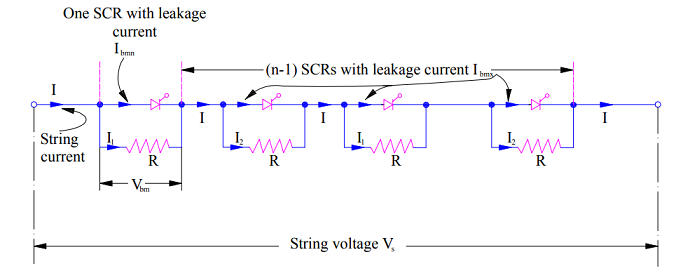String Efficiency and Derating
String Efficiency
For series or parallel connected SCRs, it should be ensured that each SCR rating is fully utilized and the system operation is satisfactory. Therefore, string efficiency is a term that is used for measuring the degree of utilization of SCRs in string. String efficiency of SCRs connected in series/parallel is defined as
$latex \displaystyle \text{String}\,\,\text{Efficiency}=\frac{{\text{total voltage/current rating of the whole string}}}{\begin{array}{l}\text{individual voltage/current rating of SCR }\times \\\text{number of SCRs in series/parallel in the string}\end{array}}$
In practice, this ratio is less than one. To obtaining the highest possible string efficiency, the SCRs connected in string must have identical characteristics. Since SCRs of the same ratings and specifications do not have identical characteristics, unequal current/voltage sharing is bound to occur for all SCRs in a string. Hence, the string efficiency can never be equal to one.
Derating
Several compensating networks used for voltage and current equalisation in series and parallel connected thyristors, respectively, have been discussed in previous sections. Although the differences in voltages/current will be reduced, these techniques do not entirely eliminate these differences. Therefore, in order to improve the reliability of the series/parallel string, an extra unit may be added so that the voltage/current applied to each device will be lower than its normal rating. Thus, there is an inherent derating of the units connected in series and parallel configuration.
The per cent derating will be given by the equations:
% parallel derating = $latex \displaystyle \left( {1-\frac{{{{I}_{m}}}}{{{{n}_{P}}{{I}_{T}}}}} \right)\times 100$; where Im = total forward current, np = total number of SCRs in parallel; and IT = forward current rating of each SCR.
Similarly, % series derating = $latex \displaystyle \left( {1-\frac{{{{E}_{S}}}}{{{{n}_{S}}{{E}_{D}}}}} \right)\times 100$; where ES = total applied voltage, ns = total number of SCRs in series; and EP = forward voltage rating of each SCR.
Derating factors are normally 8 to 20% for parallel connection of thyristors depending upon the number of devices in parallel. The other main reason for derating is poor cooling and heat-dissipation as number of devices have to appear in the same branch of the circuit.
latest video
news via inbox
Nulla turp dis cursus. Integer liberos euismod pretium faucibua









